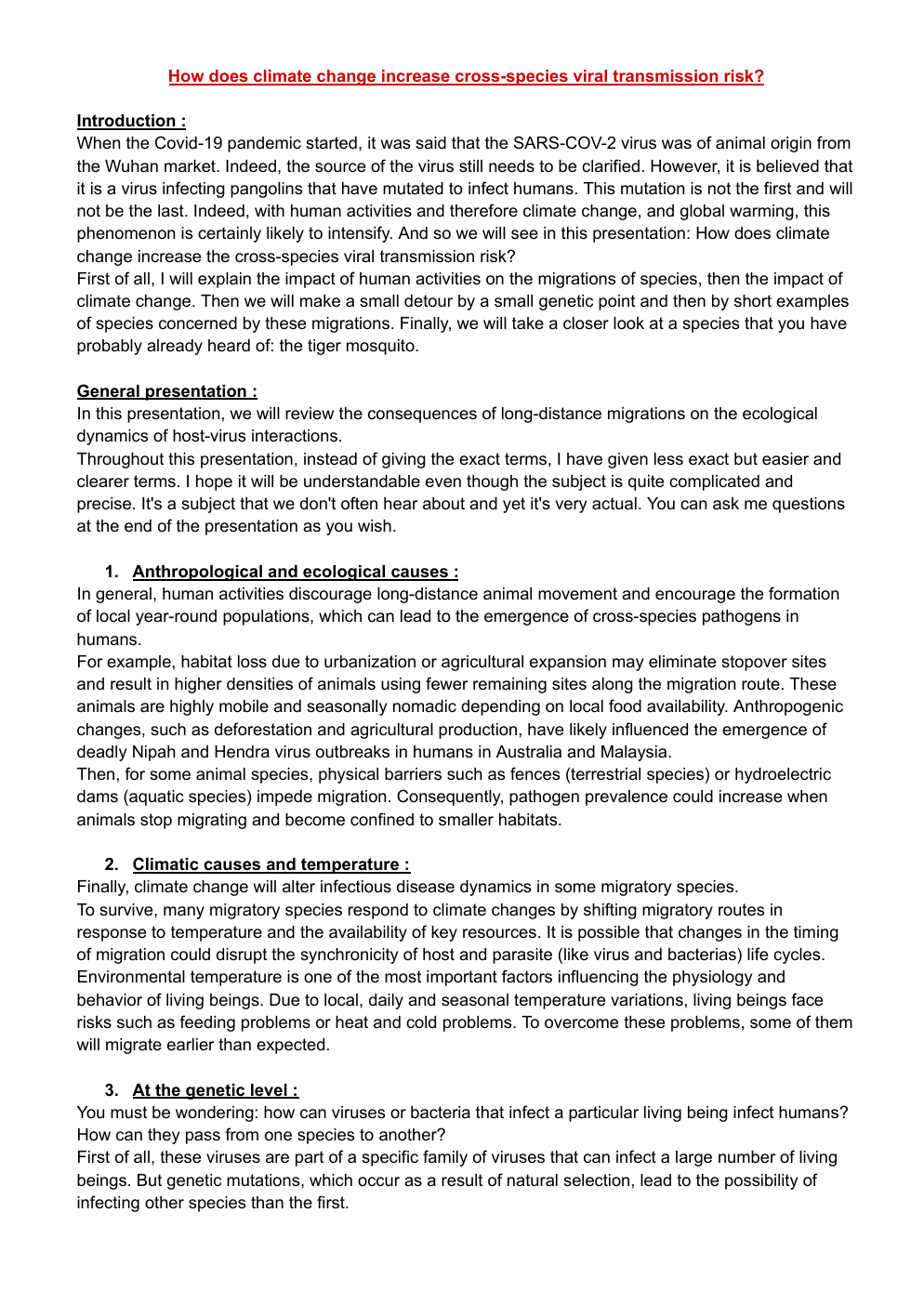How does climate change increase cross-species viral transmission risk?
Publié le 23/05/2023
Extrait du document
«
How does climate change increase cross-species viral transmission risk?
Introduction :
When the Covid-19 pandemic started, it was said that the SARS-COV-2 virus was of animal origin from
the Wuhan market.
Indeed, the source of the virus still needs to be clarified.
However, it is believed that
it is a virus infecting pangolins that have mutated to infect humans.
This mutation is not the first and will
not be the last.
Indeed, with human activities and therefore climate change, and global warming, this
phenomenon is certainly likely to intensify.
And so we will see in this presentation: How does climate
change increase the cross-species viral transmission risk?
First of all, I will explain the impact of human activities on the migrations of species, then the impact of
climate change.
Then we will make a small detour by a small genetic point and then by short examples
of species concerned by these migrations.
Finally, we will take a closer look at a species that you have
probably already heard of: the tiger mosquito.
General presentation :
In this presentation, we will review the consequences of long-distance migrations on the ecological
dynamics of host-virus interactions.
Throughout this presentation, instead of giving the exact terms, I have given less exact but easier and
clearer terms.
I hope it will be understandable even though the subject is quite complicated and
precise.
It's a subject that we don't often hear about and yet it's very actual.
You can ask me questions
at the end of the presentation as you wish.
1.
Anthropological and ecological causes :
In general, human activities discourage long-distance animal movement and encourage the formation
of local year-round populations, which can lead to the emergence of cross-species pathogens in
humans.
For example, habitat loss due to urbanization or agricultural expansion may eliminate stopover sites
and result in higher densities of animals using fewer remaining sites along the migration route.
These
animals are highly mobile and seasonally nomadic depending on local food availability.
Anthropogenic
changes, such as deforestation and agricultural production, have likely influenced the emergence of
deadly Nipah and Hendra virus outbreaks in humans in Australia and Malaysia.
Then, for some animal species, physical barriers such as fences (terrestrial species) or hydroelectric
dams (aquatic species) impede migration.
Consequently, pathogen prevalence could increase when
animals stop migrating and become confined to smaller habitats.
2.
Climatic causes and temperature :
Finally, climate change will alter infectious disease dynamics in some migratory species.
To survive, many migratory species respond to climate changes by shifting....
»
↓↓↓ APERÇU DU DOCUMENT ↓↓↓
Liens utiles
- How does Shakespeare establish the character of Richard in the first two scenes’ of Richard the III?
- Ant. Class Insecta Order Hymenoptera Family Formicidae Conservation Concerns 45 species are at risk
- THÈME 1 : La Terre, la vie et l’organisation du vivant Thème 1A : Transmission, variation et expression du patrimoine génétique Chapitre 1 : Les divisions cellulaires, transmission du programme génétique chez les eucaryotes
- RISK MANAGEMENT
- Fiche de lecture sur le chapitre 11: The Greek of the New Testament, par Mark Janse, sur la section IV de l’ouvrage, intitulé: Ancient Greek: structure and change, pages 646-653.




















